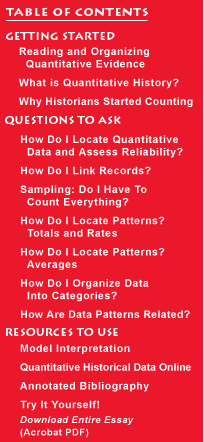talking history | syllabi | students | teachers | puzzle | about us
|
|
Does the
very thought of quantitative analysis make you shake in your shoes?
Making Sense of Numbers provides a place for students and teachers to
begin working with quantitative historical data as a way of understanding
the past. Written by Gary J. Kornblith, this guide offers an overview
of quantitative methods, how historians use historical data, and step-by-step
instructions using actual historical data to determine totals, rates,
averages, standard deviations, and coefficients of correlation. Gary
J. Kornblith is Professor of History at Oberlin College. He is currently
working with Carol Lasser and Patricia Holsworth on a social history
of nineteenth-century Oberlin, Ohio and his previous publications include
"Hiram Hill: House Carpenter, Lumber Dealer, Self-Made Man"
in Michael A. Morrison, ed., The Human Tradition in Antebellum America
(2000), The Industrial Revolution in America (editor and co-author)
(1998); and "Artisan Federalism: New England Mechanics and the
Political Economy of the 1790s," in Ronald Hoffman and Peter J.
Albert, eds., Launching the "Extended Republic":
The Federalist Era, (1996). Published online July 2002. Cite as: Gary Kornblith, "Making Sense of Numbers," History Matters: The U.S. Survey Course on the Web, http://historymatters.gmu.edu/mse/numbers/, July 2002. |
|||||

|
||||||



